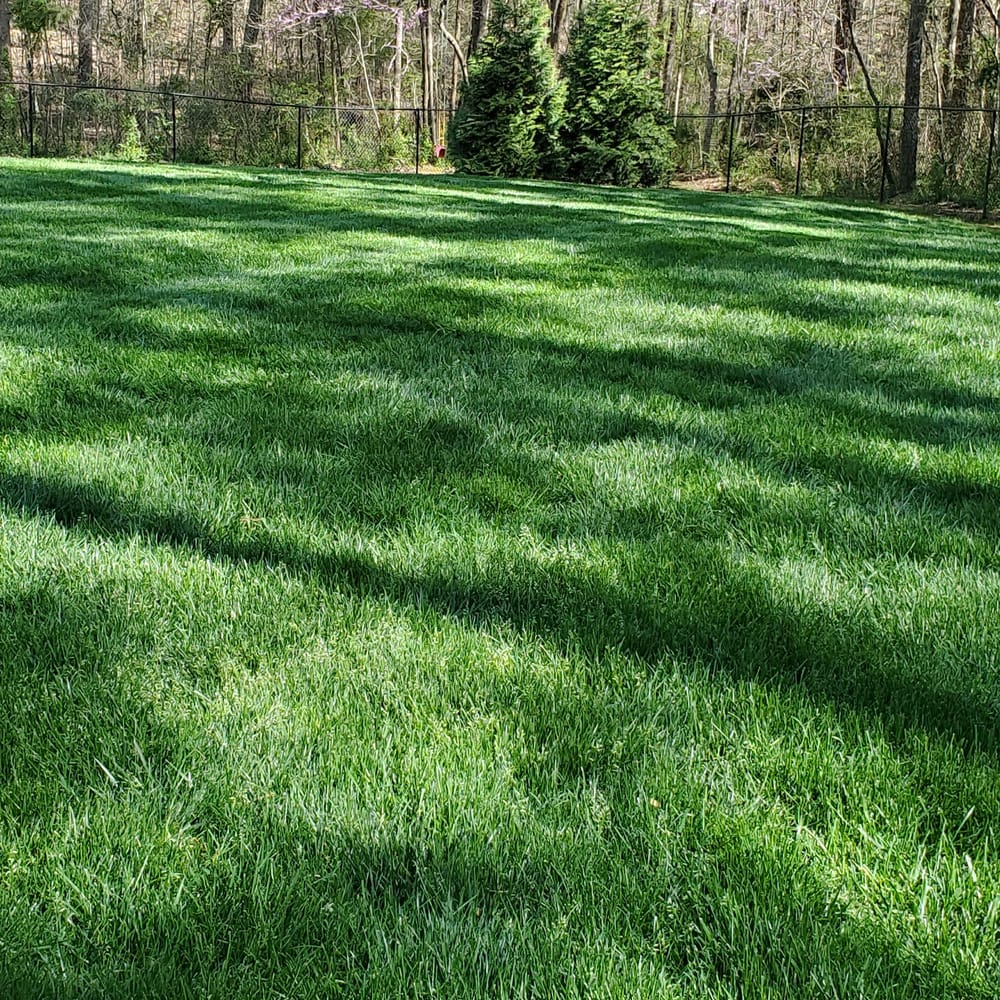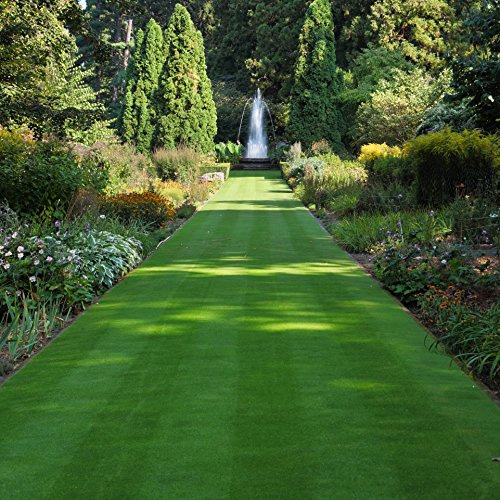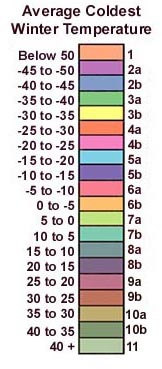
Kentucky Bluegrass - Midnight
- Dark Green Color
- Lawns
- Cost Efficient
Grasses used in Oregon only consist of cool-season grasses such as ryegrass, fine fescue, turf type tall fescue, and Kentucky bluegrass. In certain parts of the Willamette Valley colonial bentgrass if sometimes used as well.
Cool-Season Grasses:
Perennial ryegrass - Perennial Ryegrass is one of the world's most widely used, Oregon-grown grasses. Its popularity comes from its ability to germinate in 7 to 10 days or less. This fine-bladed turf grass is preferred by many home owners because of its dark color, strong root system, its fast response to fertilization and its rapid recovery from trampling. A cool-season grass, Perennial Ryegrass can adapt to many different kinds of soil, including poor soils, clay, and badly drained areas. Oregon-grown turf-type Perennial Ryegrass is a hardy grass that has been used in almost every premier sporting event including the Super Bowl, World Cup Soccer, Rose Bowl, Los Angeles Coliseum, World Series, Olympics and on the world's finest golf courses. It can be mowed as low as 3/16 inch for golf course greens, an inch or less for tees and fairways and 1 1/2 to 2 1/2 inches for home laws. This none creeping, bunch type grass likes will sun but will tolerate some shade. Perennial ryegrass is often found near coastal regions and the where summers and winters aren't too extreme.
Fine fescues - Fine Fescue is a shade tolerant turf grass with a medium to dark green color. Adapted to the Pacific Northwest, Fine Fescue grows best in cool humid regions, coastal regions and in high elevations. All varieties require little maintenance and like to be mowed at 1 1/2 to 2 1/2 inches. They have the finest leaves, the most shade tolerance and the lowest fertilizer, mowing and moisture requirements of all the cool season turf grasses. Chewings Fescue, Red Fescue, Creeping Red Fescue, Sheep Fescue and Hard Fescue are popular varieties of Fine Fescue. These varieties can be found on lawns, in parks, along road sides and other turf grass areas and extensively used in grass seed blends and mixes for both sunny and shady areas. Fine Fescues are not recommended for sports fields and golf tees because they have a low wear tolerance. Most of these varieties have all the same characteristics. Chewings Fescue has a noncreeping, bunch-type growth habit unlike Red Fescue. All varieties germinate rapidly and are well adapted to poor, dry, sandy soils.
Tall fescue - Turf Type - Tall fescue is a persistent and durable plant that forms acceptable turf for home lawns, grounds, parks, playgrounds, and athletic fields. It is commonly used in low maintenance situations such as utility areas, highway medials, airstrips, and fairgrounds. Many new and improved varieties have finer texture, higher tiller densities, and a darker-green color than the coarse-textured, light-green varieties such as 'Kentucky 31' and 'Alta.' Tall fescue is considered by many individuals to be incompatible with the finer-textured and darker-green Kentucky bluegrass, perennial ryegrass, and fine fescues. Tall fescue may be objectionable in a mixture with fine-textured turfgrass species because it tends to form coarse-textured clumps in an otherwise uniform stand.
Tall fescue is primarily a bunch-type grass that occasionally produces short rhizomes. It is somewhat slow to establish extensive root systems and has only fair recovery potential. This species is the most heat and drought tolerant of the cool-season turfgrasses. The increased drought tolerance is a function of its ability to produce a deep root system. Tall fescue performs well in open, sunny areas and is moderately shade tolerant. It is less suited to heavily-shaded conditions than the fine fescues, but is more shade tolerant than Kentucky bluegrass and perennial ryegrass. Tall fescue is best suited to well-drained soils.
Kentucky bluegrass - Kentucky Bluegrass is an easily grown, high quality perennial turf grass used in Eastern Oregon and in mixes in Western Oregon. It is most commonly used on home lawns, parks, cemeteries, institutional grounds, airfields, roadsides, golf course fairways and athletic fields because of its ability to withstand high turf injury. Its thick root system helps the plants recover quickly and prevents the plants from falling apart. Kentucky Bluegrass grows best in the north eastern and central states. This dense grass has good color, a fine texture and is the cold hardiest of all turf grasses. It has a high water requirement and may suffer in summer heat if mowed too short. Although this is popular grass seed, it has high maintenance requirements like frequent watering, fertilizing and mowing. It prefers to be mowed at 1 1/2 to 2 1/2 inches. This cool-season grass is one of the most important and widely used turf grasses.
| Click Name To View Grass Seed Choice | Type | Applications | |
|---|---|---|---|
| Cool Season Mix - Showtime |
|
Cool Season |
Lawns - Full Sun to Moderate Shade Rye, Kentucky Bluegrass, Fine Fescue Mix |
| Cool Season Mix - Garland |
|
Cool Season |
Lawns - Full Sun to Moderate Shade Rye, Fine Fescue Mix |
| Fescue/Bluegrass Mix - Combat Extreme North |
|
Cool Season | Lawns - Wear Tolerant |
| Fescue Blend - Combat Extreme Transition |
|
Cool Season | Lawns - Wear Tolerant |
| Fine Fescue Blend - Legacy |
|
Cool Season | Lawns - Full Sun To Moderate Shade |
| Kentucky Bluegrass - Bluegrass Supreme |
|
Cool Season | Lawns - Golf Gourses - Full Sun |
| Kentucky Bluegrass - Midnight |
|
Cool Season | Lawns - Golf Courses - Full Sun |
| OSP Ryegrass |
|
Cool Season | Lawns - Golf Courses |
| Shade Grass - Poa Supina Mix |
|
Cool Season | Lawns - Full Sun - Deep Shade - Best Shade Grass |


Below is the USDA Zone Map for Oregon so you can determine which zone you reside in. Below that are our picks for your state which will do best in your area. Next on this page are tables which list various grasses and their characteristics so you can compare before you decide on your purchase. Click on the product name (ie. Midnight) for more information about that grass and to make your purchase.
| USDA Zone Map For Oregon | |
|---|---|
 |
 |
| Compare Various Grasses For Their Characteristics | ||||||||
|---|---|---|---|---|---|---|---|---|
| Cool Season Grasses |
Leaf Texture |
Establish Rate |
Nitrogen Use |
Water Use |
Drought Tolerance |
Salinity Tolerance |
Shade Tolerance |
|
| Bentgrass - Creeping | Fine | Moderate to Fast |
Low to Moderate |
High | Poor to Moderate |
High | Poor to Moderate |
|
| Bentgrass - Colonial | Fine | Moderate to Fast |
Low | Moderate | Poor to Moderate |
Moderate | Moderate | |
| Bluegrass - Kentucky | Moderate to Fine |
Slow | Moderate to High |
Moderate to High |
Good | Moderate | Poor | |
| Bluegrass - Rough | Moderate to Fine |
Slow | Moderate to High |
Moderate to High |
Poor | Moderate | Excellent | |
| Fescue - Hard | Fine | Slow to Moderate |
Low to Very Low |
Moderate | Excellent | Low to Moderate |
Excellent | |
| Fescue - Creeping | Fine | Moderate | Low to Moderate |
Moderate | Good | Low | Excellent | |
| Fescue - Turf Type | Moderate to Coarse |
Moderate | Moderate to High |
Low to Moderate |
Excellent | Low | Good to Excellent |
|
| Ryegrass - Perennial | Fine to Moderate |
Very Fast | Moderate to High |
Moderate to High |
Good | Poor to Moderate |
Poor to Moderate |
|
| Compare Various Grasses For Their Characteristics - Continued | ||||||||
|---|---|---|---|---|---|---|---|---|
| Cool Season Grasses |
Fertility Needs |
Wear Resistance |
Mowing Height |
Cold Tolerance |
Acid Soil Tolerance |
Thatching Tendency |
Heat Tolerance |
|
| Bentgrass - Creeping | High | Low | Low | Low | Medium to High |
High | High | |
| Bentgrass - Colonial | High | Low | Low | Low | Medium to High |
High | High | |
| Bluegrass - Kentucky | Medium | Medium to High |
Medium | High | Medium | Medium | Medium | |
| Bluegrass - Rough | Medium | Medium | Medium | High | Medium | Medium | Medium | |
| Fescue - Hard | Low | Low | Medium | Medium to High |
Medium to High |
Low to Medium |
Low to Medium |
|
| Fescue - Creeping | Low | Low | Medium | High | Medium to High |
Low to Medium |
Low to Medium |
|
| Ryegrass - Perennial | Medium | High | Low to Medium |
Medium | Medium | Low | Medium to High |
|